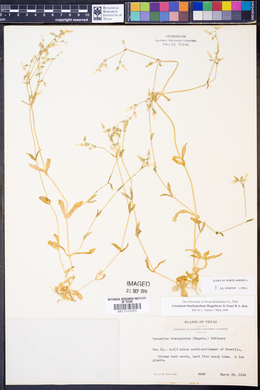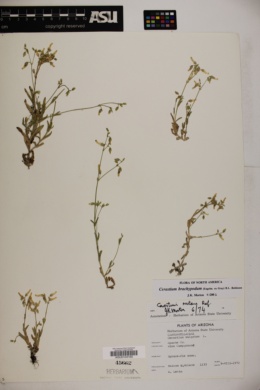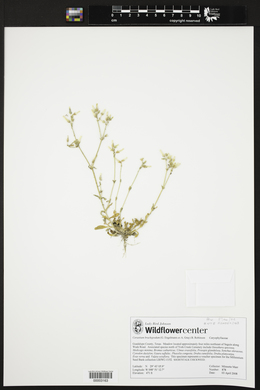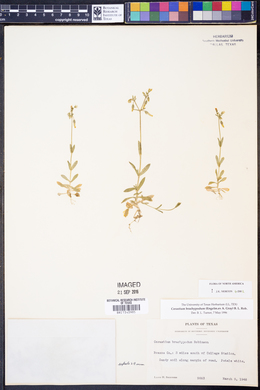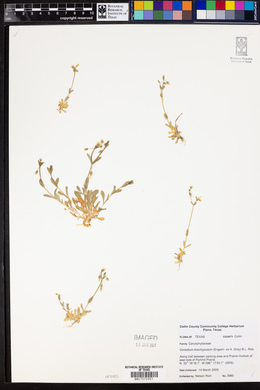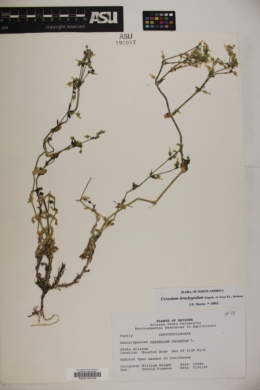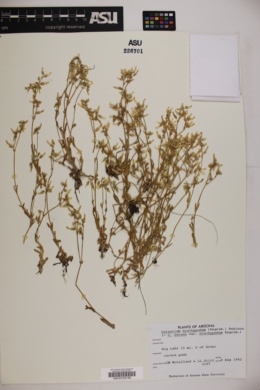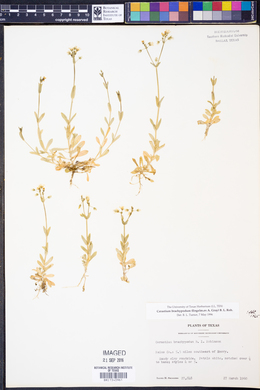Cerastium brachypodum
|
|
|
|
Family: Caryophyllaceae
Short-Stalk Mouse-Ear Chickweed, more...shortstalk chickweed, bractpod chickweed, mouse-ear chickweed, short-stalk mouse-ear chickwee
[Cerastium brachypodum var. compactum B.L. Robins., moreCerastium nutans var. brachypodum Engelm. ex A. Gray] |
Plants annual, with filiform tap-root. Stems erect, simple or sever-al from branched caudex, 5-20 cm, glandular-pubescent, nodes without long, wooly hairs; small axillary tufts of leaves absent. Leaves sessile, not marcescent, usually confined to proximal 2 of plant; mid-stem leaves with blade lanceolate to narrowly elliptic or oblanceolate, 5-30 × 2-8 mm, apex ± acute, usually rather sparsely, softly pubescent; proximal leaves sometimes forming loose rosette, blade ovate to obovate or spatulate, apex ± obtuse. Inflorescences compact to open, dichotomous, 3-30-flowered cymes, confined to distal portion of stem; bracts herbaceous, lanceolate, glandular-puberulent. Pedicels often becoming deflexed at base, 3-10(-12) mm, 0.5-1.25 times as long as sepals in flower, elongating to equaling capsule, glandular-pubescent. Flowers: sepals broadly lanceolate, 3-4.5 mm, apex subacute, glandular-puberulent to glabrate, hairs shorter than sepal tip, outer sepals herbaceous or with narrow margins, inner with broad margins; petals ovate-elliptic, 3-4 mm, equaling or shorter than sepals, apex 2-fid; stamens 10; styles 5. Capsules cylindric, curved, 6-12 mm, 2-2.25 times as long as sepals; teeth 10, erect, margins convolute. Seeds golden brown, 0.4-0.7 mm diam., tuberculate, especially around edge; testa not inflated. 2n = 34. Flowering spring and early summer. Grasslands, fields, meadows, open woods, roadsides, waste places, often in seasonally wet rocky or sandy ground; 100-2700 m; Alta., Man., Ont., Sask.; Ala., Ariz., Ark., Colo., Ga., Idaho, Ill., Ind., Iowa, Kans., La., Mich., Mo., Mont., Nebr., Nev., N.Mex., N.Dak., Okla., Oreg., S.C., S.Dak., Tenn., Tex., Utah, Va., Wis., Wyo.; Mexico. Cerastium brachypodum differs from C. nutans in its smaller size; its short pedicels, which often become deflexed at the base instead of near the capsule; and its pubescence, which is usually sparser and lacks any long, lanate hairs. However, some specimens from the arid region of the southwest have a dense gray pubescence. Plants from the Arizona desert, which have particularly long and narrow capsules, are the basis for the erroneous report of C. gracile Dufour from that region. Cerastium fastigiatum can be very similar to C. brachypodum but differs in its longer pedicels, narrowly acute leaves, glandular pubescence on the stems, and much more branched (fastigiate) habit.
Annual herb with a thread-like taproot 5 - 20 cm tall Stem: upright, unbranched or branched, glandular-hairy. Leaves: opposite, stalkless, 0.5 - 3 cm long, 2 - 8 mm wide, lance-shaped to narrowly elliptic to reverse lance-shaped with a more or less pointed tip, sparsely soft-hairy. The lower leaves sometimes form a loose rosette. These leaves are egg-shaped to reverse egg-shaped with a more or less blunt tip. Inflorescence: a more or less open, branched cluster (cyme) of three to thirty flowers subtended by glandular-hairy, lance-shaped bracts. The bracts are entirely green and lack scarious (dry, thin, and membranous) margins. Flowers: white. Stalk often bent downward at base, 3 - 10 mm long, glandular-hairy. Stamens ten. Styles five. Sepals: five, distinct, 3 - 4.5 mm long, broadly lance-shaped with a nearly pointed tip, glandular-hairy to nearly hairless. Petals: five, white, 3 - 4 mm long, egg-shaped to elliptic, two-lobed, clawed. Fruit: a dehiscent capsule (opening by ten short, upright teeth), 6 - 12 mm long, about two times as long as the sepals, cylindrical, curved. The stalks are about equal the length of the capsules. Seeds numerous, golden brown, egg- to kidney-shaped, dorsally grooved. Similar species: Having entirely green, non-scarious bracts helps to distinguish this species, Cerastium glomeratum, and C. nutans from most other Cerastium in the Chicago Region. Cerastium glomeratum differs by having very pointed sepals. Cerastium nutans differs by having fruit stalks that are longer than the capsules. Flowering: late April to early June Habitat and ecology: Introduced from south of the Chicago Region. Found in waste ground and in the cinders of railroad ballast, mainly in the western counties of the region. Occurence in the Chicago region: non-native Etymology: Cerastium comes from the Greek word keras, meaning horn, referring to the horn-like shape of the seed capsule. Brachypodum means short-stalked. Author: The Morton Arboretum FNA 2005, Keanry and Peebels 1969 Duration: Perennial Nativity: Native Lifeform: Forb/Herb General: Herbaceous annuals, 5-20 cm high, stems erect, simple or several, arising from a branched caudex, herbage glandular-pubescent, stem nodes without long, wooly hairs (*sometimes densely gray-pubescent, see Notes), plants with a filiform taproot. Leaves: Opposite, sessile, not persistent, most blades lanceolate to narrowly elliptic or oblanceolate, 5-30 mm long and 2-8 mm wide, apices acute, surfaces usually sparsely and softly pubescent, proximal leaves sometimes forming a loose rosette, when present these blades ovate to obovate or spatulate with rounded tips. Flowers: Bright white, petals 4-5, ovate-elliptic with a 2-fid apex, 3-4 mm long and equaling or shorter than the sepals, sepals broadly lanceolate, 3-4.5 mm, apices subacute, surfaces glandular-puberulent to glabrate, outer sepals herbaceous or with narrow margins, inner with broad margins, stamens 10, anthers bright yellow, filaments distinct, inserted at base of ovary, nectaries at base of filaments opposite sepals, styles 5, subtending bracts of the inflorescence herbaceous and lanceolate with glandular-puberulent surfaces, inflorescences of compact to open, dichotomously branching, 3-30-flowered cymes, these usually confined to the stem tips, pedicels glandular-pubescent, often becoming deflexed at base, 3-12 mm long, elongating to equaling the capsules in length. Fruits: Cylindric, curved, erect, with convolute margins, 6-12 mm long, 2-2.25 times as long as the sepals, capsules opening by the dehiscence of 10 small teeth at the tips of the capsule, forming a sunburst shape at the top of the capsule. Seeds golden brown, 0. Ecology: Found on seasonally wet rocky or sandy soils, in grasslands, fields, meadows, open woods, roadsides, waste places, from 350-9,500 ft (106-2896 m); flowering spring-early summer. Distribution: Found throughtout most of the United States, not occurring in California, or Nevada in the southwest or in the most north-eastern states. Ethnobotany: Specific uses for this species are unknown, but other species in the genus have uses. Synonyms: Cerastium brachypodum var. compactum, C. nutans var. brachypodum Editor: LCrumbacher2012 Etymology: Cerastium comes from the Greek keras, "a horn," referring to the shape of the seed capsule, and brachypodum comes from the Greek brachys, "short," and podion, "a little foot," thus meaning "short-footed" in reference to the pedicels of the spikelets. |






















